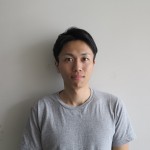
Hiromi Miwa
Keio University
Applied Chemistry
Status: B4 Expected Graduation: March 2017
Research Host Lab: Bao Lab, Bioengineering, Rice University
![]() Research Project Poster: “Identifying and validating CRISPR/Cas9 off-target activity”
Research Project Poster: “Identifying and validating CRISPR/Cas9 off-target activity”
Why Nakatani RIES?
As an undergraduate student, my current academic goal is acquiring knowledge to develop point-of-care devices and improve health care environment. I am particularly interested in diagnostic devices and want to engage in the development of such devices in the future. The U.S. has the most advanced technologies in this field, and my ambition is to pursue research there after completing my undergraduate degree in Japan. I wish to participate in the science and research internship at Rice University as a step toward realizing such goals. During the internship, I am keen to expose myself to a variety of different viewpoints and opinions within my field.
Goals for the Summer
- Visiting laboratories
- Expose myself to many viewpoints
- Gain research experience in different topics
- Making friends who want to study abroad
Excerpts from Hiromi’s Weekly Reports
- Week 01: Arrival in the U.S.
- Week 02: First Week in My Research Lab at Rice
- Week 03: Interview with a U.S. Researcher
- Week 04: Reflections on English Language & Life in the U.S.
- Week 05: Research in the U.S. vs. Research in Japan
- Week 06: Final Week at Rice & Research Poster Presentation
- Week 07: Visit to Washington, DC & New York City
- Final Report: Reflections on the Nakatani RIES Fellowship
Week 01: Arrival in the U.S.
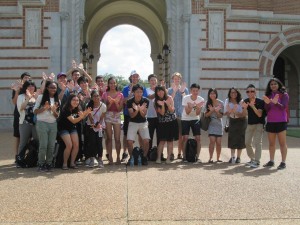
On the first day of this program, I was a leader of the group of Nakatani RIES U.S. and Japanese Fellows including Brianna Garcia, Nickolas Walling, Erica Lin and Ayaka Yoshida. When I talked with the U.S. fellows, especially Nickolas, they asked me about the meaning and origin of Kanji. Actually, I never cared about the origins of Kanji before, so I was not able answer fully. This difference of viewpoints is very interesting. I want to also provide this kinds of new perspectives to U.S. students. I also found the seminar given by Prof. Junichiro Kono on “Graduate Study & Research in the U.S.” very helpful because I want to pursue a Ph.D in U.S. To help me prepare my statement of purpose for my graduate school applications, understanding a professor’s viewpoint is very important. I am not incorporating his advice into the first draft of my statement of purpose for my applications to to U.S. universities.
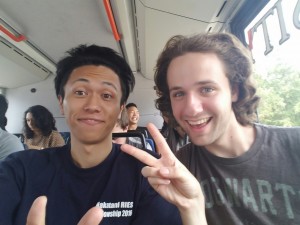
After museum, I took a picture with Nickolas. He is very kind and fanny! ~ Hiromi Miwa
My initial reactions to the U.S. was that everything is really huge. From the airplane, I watched the huge center pivot irrigations. I was very surprised that the one huge center pivot irrigation is the same size of the one city. At Space Center Houston, I walked around with Nickolas, who is very funny. He told me about famous dishes from his home state of Louisiana, crabs and shrimp, and gave me recommendations of where I could eat that kind of seafood in Houston. He also introduced me to many campus events that will be held at Rice University. I cannot wait to attend these events with him.
Question of the Week
U.S. fellows (Nickolas) often touch girls’ hair! It is very surprising for Japanese. If I have a chance, I will try to touch girl’s hair!
How did you prepare for your research experience at Rice University before you left Japan?
My future plan is help improve medical equipment to solve medical access problems in rural or low-resource areas. This research field is a very interdisciplinary area. To prepare for interdisciplinary research project, I want to expose myself to different research topics. Therefore, I chose totally different research area in Nakatani-RIES from my previous research experience.
To prepare before coming to the U.S., I read several articles to become familiar with the new research topic, gene editing technology, before this program. That was a really tough process. Everything was new for me. To understand one article, I needed more than one day. However, the experience of learning a new field is very helpful to my future goals, and I look forward to cooperating with people who have many different backgrounds.
Week 02: First Week in My Research Lab at Rice
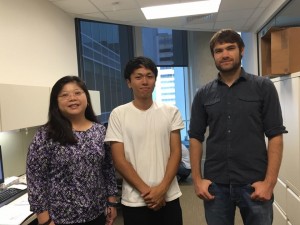
The right side is Amy Tang and the left side is Ciaran Lee. The canter is me! ~ Hiromi Miwa
The my first day in the Bao Lab, I was introduced to my lab members and attended lab meeting. To tell the truth, I could not understand the point of presentation at all because biological technologies are totally new for me. However, I decided to try studying hard to understand their presentation at the next week.
This picture is of me and my mentor, Dr. Ciaran Lee and the lab manager Amy Tang. Dr. Ciaran is Irish and he has belonged to this lab for 3 years. He gave me an overview of his projects that established that genome editing is a robust tool for expressing protein fusion to report subcellular localization and dynamics.
To communicate with laboratory members smoothly, I often use pen and paper. If I ask them to show their ideas on a paper, they kindly write down their ideas. This makes a tremendous contribution to the exchange of opinions with lab members. Furthermore, in this laboratory, there are many whiteboards. This is also useful to communicate with group members.
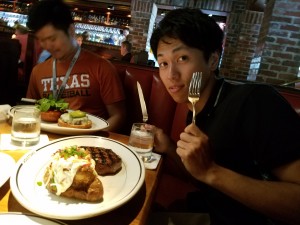
At the restaurant, I am eating a beef steak. That is very big and taste good! ~ Hiromi Miwa
And this Friday, I went to restaurant with my lab members. I ate a beef steak there. I was surprised how large the steak is. It is the twice size compared to Japanese one. And taste is really good. However, the price is also twice compared to Japan.
Question of the Week
Why do U.S. researchers read so many articles? In Japan, many people often conduct experiments. However, U.S. researcher often read articles.
- Reading research articles helps you keep informed about new accomplishments or research topics in your field and what your research competitors might be working on. Also, most journals like to publish new and innovative ideas so if the topic you are interested in already has many people writing about it you may need to come up with a new/innovative way to frame or discuss your individual project for the best chance of your paper being selected for publication by the journal editor. Also, it slightly depends on your goals too. If you plan to just get your Master’s and then get a job in industry maybe the types of papers you read might be more focused on the industry you hope to get a job in but if you want to go into academic research you must become a very good reader and writer of research papers to be most successful.
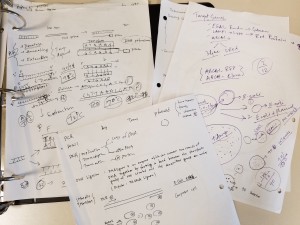
This white paper is useful to communicate with lab members. ~ Hiromi Miwa
Research Project Update
My research goal is to achieve the modified genome and analyze a cell. To conduct my research, the most important equipment is the polymerase chain reaction (PCR) which is based on using the ability of DNA polymerase to synthesize new strand of DNA complementary to the offered template strand. At the end of the PCR reaction, the specific sequence will be accumulated in billions of copies. Because of this technology, we can analyze DNA sequence. Therefore, I learned how to use and mechanism of PCR this week. Furthermore, our target is plasmid. It is a small, circular, double-stranded DNA molecule that is distinct from a cell’s chromosomal DNA. We have taken advantage of plasmids to use them as tools to clone, transfer, and manipulate genes. This plasmid can be introduced into a bacterium by way of the process called transformation. Then, because bacteria divide rapidly, they can be used as factories to copy DNA fragments in large quantities. Based on this technique and target, I will conduct my research projects in the Gang Bao laboratory.
Week 03: Interview with a U.S. Researcher
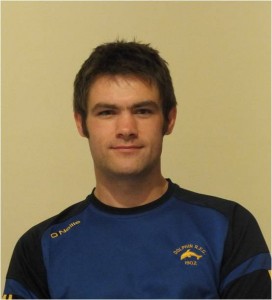
I talked with my mentor, Ciaran Lee. He got his BS and Ph. D at University College Cork. He then spent 2 years as a researcher at University College Cork. He has been working in Prof. Gang Bao’s lab from 2013. When he was looking for a job, Gang Bao was also looking for a researcher who had a background in gene-editing technology because he wanted to enlarge his research field to biology. Therefore, after his research experience at University College Cork, he was invited to join the Bao laboratory. He decided to research gene-editing technology because of a seminar course he took. In the seminar, he read many articles related to gene-editing technology. He was attracted to gene-editing because it has the potential to make a big impact on our society. His research field was that ZFN and TALEN, which is conventional gene-editing technique and now he conducts the project of CRISPR/Cas9, which is the latest gene-editing technology. According to his experience, Ireland and the U.S. research environment is totally different. First of all, in Ireland, undergraduate tuition and fees are free. That was very surprising for me. He said that the government invests a lot of money into education. On the other hand, it is very difficult to get a grant in Ireland compared with U.S. Thus, he likes research environment at Rice University where there is a lot of expensive equipment in Prof. Gang Bao’s laboratory.
His future plan is to set up his own laboratory. In his laboratory, the main research topic would basic biology, revealing the mechanism of mutation. He said that if gene-editing technology will be more precise and flexible, we can analyze mutations of the cell and DNA. Furthermore, he also wants to research how to treat mutational diseases. In summary, he will try to research mutation from basic perspectives and application viewpoints. By the way, I asked him that if you have a chance to get a different job, what kind job would you choose? He answered that he would want to establish his own consulting company to assist the development of science. According to his plan, his company would assist to make workflow and how to deal with technical problems, such as drug screening. Even if he can change his job, he would still try to develop science. This is because he is very curious that of what can be accomplished by using science. To discover new things, he always tries hard.
He is also very interested in Japanese culture. His roommate at the Georgia Institute of Technology was Japanese. Because of his Japanese friend, he knows a lot about Japanese culture. Furthermore, his wife is now working in sushi restaurant. If he has a big holiday, 3 or 4 weeks, he would like to travel to Japan with his wife.
Reflections on Interview
My impression of this interview is that Ciaran really loves science and has a clear plan. He happily shared his research interests with m and he shared with me what he wants to do and how he hopes to achieve his plan in this interview. I now understand that conducting research happily and having a clear vision is very important to be a good researcher, like him. Furthermore, I was surprised that the difference between Irish, U.S. and Japan. I hope that tuition fee will be free in Japan same as Irish and Japanese researcher will get funding more easily for research grants as you can in the U.S.
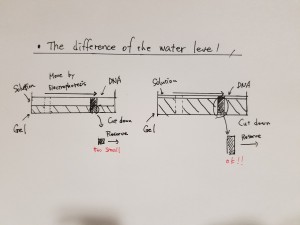
Research Project Update
This week, I mainly conducted two kinds of experiments. The first one is purification of total DNA. This is conducted by the simple kit. After purification of DNA, DNA can be ready to use. The second one is electrophoresis. This is a very basic experiments to separate and analyze of macromolecules (DNA, RNA and proteins) and their fragments, based on their size and charge. However, I found that there is some difference between chemistry and biology when I conduct this experiment. In the biology field, we need to cut off the gel after electrophoresis to reserve. To reserve many DNA, we do not pore much solution. (See picture) However, in the chemistry field, we do not need cut off the gel because chemicals are not needed to reserve. Thus, we are not really serious about the water level. Furthermore, biology experiments need much more time compared to chemistry experiments, so I should be careful not to make mistakes. From this week, I started many experiments and learned many different things from my previous research experience. Because of this difference of background, I made many mistakes. However, I would like to make use of this experience next time. I believe that this experience will be helpful when I conduct interdisciplinary project in the future.
Week 04: Reflections on English Language & Life in the U.S.
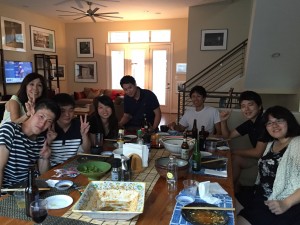
In my laboratory, there are many Chinese members. However, my professor strongly recommended that we speak in English. He thinks that communicating in English is important for researchers. Therefore, all members speak in English. One of the difficulties of communication in my laboratory is that I am not familiar with the terminology in biology in English. I can catch the words but I cannot understand the meaning of what they say. At first I was really confused this situation. By learning, basic biology terms, I have been able to better communicate with researchers in my lab. Dealing with this difficulty is crucial for me because microfluidics, my research topic is an interdisciplinary research field. We are always required to learn new technologies and new knowledge. My acquaintance who works in the same field always says that he needs new knowledge depending on the project. Therefore, being exposed to different research fields is definitely helpful for my future research. And learning new things is really exciting for me!
When I face difficulties communicating in English, I always use nonverbal skills. This week, I attended a Japanese language table host by Prof. Ozaki for students studying Japanese at Rice. While there, I talked with a Chinese student, Kyle Chow. He likes Japanese singer, Kyary Pamyu Pamyu and so on. When I asked him what singer do you like or what song do you like, the smartphone was very useful to share images. By sharing an image, we can easily talk about same topics in Japanese (or English). I think we should use not only language but also nonverbal skills. In the U.S., I understand that nonverbal communication is very important in communication.
My special technique to improve my English communication skill is reading English books. I love to read books. After I read a translated version of the book, I often read it again in the original language. When I was a junior high school student, I read Harry Potter. To learn English, I read original version again in when I was a college student. This was a very useful way to learn English as there were many daily conversations. Furthermore, by comparing the two versions, I can find that there are many differences of expressions. This difference is also interesting because there are many cultural back ground of this expression of difference.
Question of the Week
Why do Americans not eat burdock? This weekend, all of the Japanese fellows were invited to Prof. Shimizu’s house. At first, she wanted to make Tikuzenni, however, there was no burdock at the supermarket. One possible reason of there was no burdock at the supermarket is a cultural difference. In U.S., a root is not for eating. Takada told us that U.S. prisoners did not eat roots in the WWⅡ.
- Burdock root is actually not native to the U.S., though it is a native plant in Asia and Europe. So, people in the U.S. don’t eat it as it was not an ingredient that you could obtain since it didn’t grow here. Though the burdock plant was introduced to the U.S. eventually, it was a wild plant and seen as a weed. Not eating burdock isn’t cultural so much as Americans simply not knowing you can eat it or how to cook/prepare it – after all there are lots of root vegetables we do commonly eat like potatoes, carrots, radishes, etc. Since the burdock plant is seen as a weed, its root is not typically sold at grocery stores in the U.S. though you can sometimes find it at Asian grocery stores. For most Americans, the first time they will eat burdock root is when they travel abroad to a country like Japan where it is pretty common and it can be a bit confusing to ask “What is this?” and be told “Burdock” only to have the American be even more confused and ask again, “What’s burdock?”.
- However, typical American food is not as rich or diverse in flavors and ingredients as you will find in countries throughout Asia. In comparison, traditional American food and ingredients can seem quite boring or bland and many Americans may not be very comfortable trying new types of food or ingredients that are outside of their comfort zone. This is changing though as the country becomes more diverse and cities like Houston especially have many, many different types of restaurants and supermarkets for everything from Japanese to Russian food. Today, young professionals and college students are more likely to have tried many different types of food and to use a more diverse range of ingredients in their own cooking than their parents or grandparents generation in the U.S.
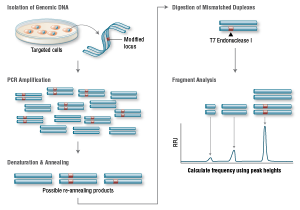
Research Project Update
This week, I mainly worked on the purification of modified DNA and estimated the efficiency of modification. In our project, we insert new sequences to wild DNA. At first, we need to extract DNA from reagents. To extract DNA, we use magnetic nanoparticles. Adding magnetic nanoparticles to solution, we can extract DNA because DNA binds with magnetic nanoparticles. And we need to calculate how much mutation has occurred in the DNA sequences to estimate the efficiency of this insertion. To calculate the percentage of mutation, we use the T7 Endonuclease I mutation detection assay. This assay detects heteroduplex DNA that results from the annealing (complementary sequences of single-stranded DNA or RNA to pair by hydrogen bonds to form a double-stranded polynucleotide) of a DNA strand, including desired mutations, with a wildtype DNA strand. Genomic DNA is amplified with primers bracketing the modified locus. These DNAs are then denatured and re-annealed yielding 3 possible structures. Duplexes containing a mismatch are digested by T7 Endonuclease I. The DNA is then electrophoretically separated and fragment analysis is used to calculate targeting efficiency. Finally, we can find out that this modification works well (more than 70 %).
Week 05: Research in the U.S. vs. Research in Japan
I expected to learn about genome-editing technology in this program. As I expected, now I conduct gene-editing research projects. I was very surprised by the versatility of gene-editing technology. However, at the same time, I understand that it is very difficult to apply this technology to my research project right now. One of the difficulties is CRISPR/Cas9, one of the genome-editing technology, is still unknown in many parts. I expect that CRISPR/Cas9 technology will be tractable as soon and hope to apply this technology to future diagnostic devices.
The rule of the lab is that all lab members always have to speak in English. This direction is strongly recommended by Prof. Gang Bao. My laboratory in Japan also has a similar rule that lab members have to present their research reports in English. My laboratory in Japan has many international students, so we often talk in English to communicate with international students. From this experiments, I think that many professors value speaking in English in research fields.
In my U.S. laboratory, there are two projects and leaders. If we face a problem, usually the lab members will talk with these leaders. This is very similar to my Japanese laboratory situation. My Japanese laboratory also has two research projects and these projects are organized by two doctoral students. Therefore, they are always busy dealing with all of the problems that happened in the laboratory.
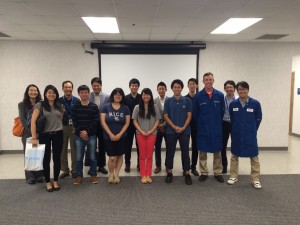
At first, I was told that only results were valued in the U.S. by many people. However, my impression is different. My working attitude (or work ethic) towards the research project is also valued in the U.S. My mentor said that my working style is really faithful. On the other hand, there are some differences between Japanese and U.S. laboratories. There are no core working hours in my U.S. laboratory. By contrast, in Japan, many laboratories set core working hours to coerce students to work. From this fact, how long you work each day is not evaluated or monitored in the U.S. Furthermore, in the U.S. there are no education relationships between students. In my Japanese laboratory, two master students become a mentor with each undergraduate students. However, in U.S. (in my host lab), there do not have this kind of mentorship system. Basically, students conduct their own projects by themselves. If they have a problem, they talk with the project leader.
During this week, we also visited Kuraray, a Japanese company in Houston. I asked the Kuraray staffs about the cooperation of different field to improve performance of products. They answered that they proactively introduce diversity into their company. These days, it is difficult to advance research without cooperation from different fields. From this visit, I was able to understand the importance of diversity in the research and industrial field. Furthermore, I again recognize that this program is very helpful to conduct interdisciplinary projects in the future (At the same time, I keenly realize how difficult it is to work with or in different research area.)
Questions of the Week
Why we call doctoral degree Ph.D.? As U.S. fellows are curious about Kanji, I am also curious about English word’s meaning and its etymology. In my memory, at first every doctoral degree was Philosophical degree in the past. Therefore, we call doctoral degree philosophical degree (Ph.D.). This is very interesting because I think language is affected by the culture and history.
- You are correct, a Ph.D. is the abbreviation for a Doctorate of Philosophy degree. The term doctoral student or doctoral degree are just alternate ways of saying that this relates to a Ph.D. You can consult Google-sensei to learn more. He’s very helpful with etymological questions.
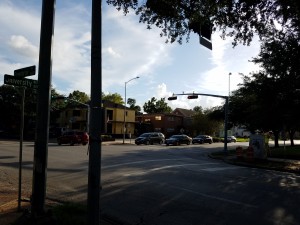
How long is the running track around Rice University campus? Every weekend, I run from Residence Inn and run around Rice Campus and back. I think this route is about 10 km or so.
- Again, Google-sensei is great with these types of questions. I typed in “How Long in the Rice University Running Trail and got lots of helpful answers confirming that the running trail around Rice campus is 2.9 miles long (4.66 km). You can also use running tracking apps to find out how long your specific route is, round-trip.
Research Project Update
During this week, I started to draft my poster for the final presentation. To make a good poster, I needed to do two tasks. The first one was reading many articles related to my research project. This was very useful to get a deep understanding of the background of my research projects. The format of a poster and article is very similar (start from an introduction to a conclusion). Therefore, reading articles was very helpful to make my poster. Furthermore, I did supplementation experiments. In bio-experiment, there are many inhibitors. Even if DNA is slightly contaminated, the result is tremendously affected. In my some previous experiments, I could not get enough data because of contamination or unknown errors. To compensate this result, I did same experiments. If I have time, I want to do further experiment to advance my research project.
For the next week presentation, I will briefly summarize my poster presentation. CRISPR/Cas9 systems are a versatile tool for genome editing due to the highly efficient targeting of DNA sequences complementary to their RNA guide strands. However, it has been shown that RNA guided Cas9 nuclease cleaves genomic DNA sequences containing mismatches to the guide strand (Off-target). A better understanding of the CRISPR/Cas9 specificity is needed to minimize off-target cleavage in large mammalian genomes. We show that percentage of on-target site cleavage and genomic sites could be cleaved by CRISPR/Cas9 systems when DNA sequences contain insertions or deletions compared to the RNA guide strand.
Week 06: Final Week at Rice & Research Poster Presentation
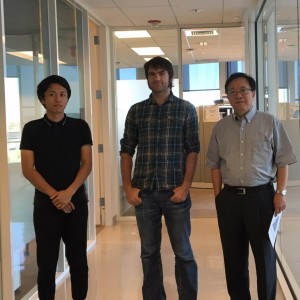
Based on this experience, my perceptions towards not only U.S. but also Japan have been tremendously changed. Many Japanese think that Japan has the greatest hospitality in the world. However, I now understand that U.S. has also a good hospitality. In the restaurants, they are very kind to us. Furthermore, when I ask the way, people in the U.S. always tell me the way kindly. This has been impressive enough to change my perception towards U.S.
This research experience also contributed to changing my impressions towards research in U.S. At first, my impression towards U.S. research was that it was more like a company, compared to research in Japan. We are always required to get good results. In some aspects, this is true, however, U.S. research has also different aspects. First of all, U.S. laboratories provides research opportunities for undergraduate students. In Japan, usually we start my research experience only from our senior (B4) year. In the U.S., on the other hand, students can start research experiences even if they are only a freshman (B1) student. This can be a burden for researchers in laboratory who have to train young students. However, my laboratory accepts not only me, a new international research student, but also other undergraduate students. This is a really good way to contribute to developing the future potential researchers.
By living in U.S., I now understand the importance of accepting my weak points. In the U.S., I have faced many difficulties. To deal with these problems, we needed to understand what the cause is, and usually these were my own weak points. By facing my weak points, I can find the cause of problems. In this program, I often pretended that I can do everything by myself. However, in many situations, I needed helps from others. By accepting this fact, I changed my attitude from doing everything by myself to cooperating with many people. This is a very important thing to learn for conducting interdisciplinary projects in the future. If I conduct interdisciplinary projects, I may face many difficulties. Therefore, I want to apply this experience and knowledge to my future research experiences.
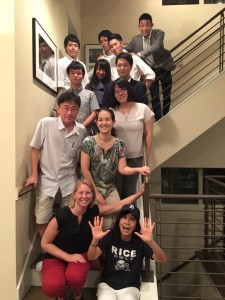
During my final week, I not only prepared for my poster session, but also did many experiments. My lab members are hopeful that I will be able to come back to this laboratory (or this research field). Therefore, they told me that the more knowledge and more experiments I can do now may help mem for my future opportunities. Fortunately, I almost finished wth my poster, so I was very glad to be exposed many different experiments. As a result, I was able to contribute to not only my projects, but also other ongoing projects. And I really appreciated the support of not only my mentor, Ciaran Lee and Professor Gang Bao, but also Amy Tang and Tim Davis. Tim Davis especially was very helpful as I worked on my research project with him. He is very gentle and kind, even if I asked many basic questions. Furthermore, he told me many things not only related to my research projects, but also other aspects of biology. This was very helpful for me to conduct biology study.
The RCQM poster session was a very good opportunity for me. In this session, almost of the audience members were not familiar with the biology field. Therefore, the purpose of my poster presentation was explaining my research easily to make it understandable for a general audience. Because of the many lectures, and advice from my mentors, my explanation of project greatly improved. In the poster session, many people said that my explanation was very simple and understandable. Especially, Bryan Anthonio and Xinwei Li, members of the Kono Lab, were interested in my projects. Based on this experience, I would like to have more opportunities to present at poster sessions in the future.
I did not have a chance to eat T-bone steak during this program. Therefore, in the my next visit to Texas, I definitely plan to eat a big and fantastic T-bone stake. This is my motivation to come back to Houston.
Questions of the Week
Why do buildings in the do not have many advertisements in the streets and on the wall of buildings. In Japan, there are many advertisements in the town.
- In Houston, buildings do not have many advertisements on the walls since most people commute by car. Therefore, along the highways there are many large billboards/advertisements and there are many, many commercials on radio stations since most people sit in traffic for a long time in the morning and evening. In cities with large public transportation networks, such as New York city or DC, there are more small advertisements in subways or posted on buildings but less than in Japan. Most advertising in the U.S. is done via TV or radio commercials or in newspaper ads.
Why do we have to pay tips in restaurant in the U.S.
- Waiters and waitresses and some other professions (like taxi drivers or hairstylists) in the U.S. are paid a lower minimum wage than any other worker with the expectation. For example, the minimum wage in Texas is $7.25 per hour for almost all jobs but for waiters and waitresses can be paid as little as $2.13 per hour. The expectation is that a waiter or waitress will make up the difference in the wage through tips and that this will encourage the waiter or waitress to provide good customer service. If they provide good customer service they will typically receive more in tips. If they are a bad waiter/waitress they will likely receive less in tips. Click here for more on tipped wages in the U.S.
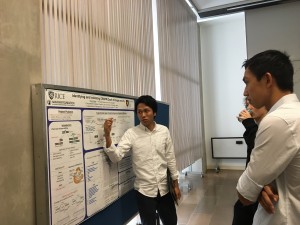
Final Research Project Update
Research Project Poster: “Identifying and validating CRISPR/Cas9 off-target activity”
Hiromi Miwa1,2, Tim Davis2, Ciaran Lee2, Gang Bao2
Research Host Lab: Bao Lab, Bioengineering, Rice University
Introduction: Recently, Genome-editing technology is getting attention in the many fields, GM foods and gene-therapy. Especially CRISPR/Cas9 systems are widely used as a gene-editing technology, because of its versatility for genome editing due to the highly efficient targeting of DNA sequences complementary to their RNA guide strands. However, it has been shown that RNA guided Cas9 nuclease cleaves genomic DNA sequences containing mismatches to the guide strand (Off-target). A better understanding of the CRISPR/Cas9 specificity is needed to minimize off-target cleavage in large mammalian genomes. We show that percentage of on-target site cleavage and genomic sites could be cleaved by CRISPR/Cas9 systems when DNA sequences contain insertions or deletions compared to the RNA guide strand.
Approach: We did two experiments. Firstly we did T7 Endonuclease I mutation detection assay to calculate the percentage of mutation. This assay detects heteroduplex DNA that results from the annealing (complementary sequences of single-stranded DNA or RNA to pair by hydrogen bonds to form a double-stranded polynucleotide) of a DNA strand, including desired mutations, with a wildtype DNA strand. Genomic DNA is amplified with primers bracketing the modified locus. These DNAs are then denatured and re-annealed yielding 3 possible structures. Duplexes containing a mismatch are digested by T7 Endonuclease I. The DNA is then electrophoretically separated and fragment analysis is used to calculate targeting efficiency. Secondly, we did DNA sequencing to get a profile of DNA sequence. DNA sequencing provides the most complete characterization of recombinant plasmid DNAs. Using primers targeting the plasmid backbone and/or the insert sequence, the identity and order of nucleotide bases for any given DNA can be determined. In the context of cloning, sequencing allows users to confirm the DNA sequence of the insert.
Getting these results from experiments
- Efficiency of on-target cleavage
- Gene modification with R-02 at on-target and off-target sites
Discussion
- We confirm the Achieved the high level of on-target modification
- Determined the on-target and off-target gene modification
Future Research
- Examine further off-target cleavage
- Investigate the effect of cell types
- Redesign guide RNAs to reduce off-target cleavage
Week 07: Visit to Washington, DC & New York City
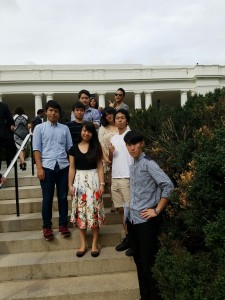
During this week, we visited Washington, DC and New Yore City. The most impressive activities for mere was the art in NY. I am not familiar with orchestra, musical and arts. However, during this week, I visited many museums and the New York Symphony Hall. I became more interested in these cultural things. In the future, I want to expose myself more music and arts.
We had many opportunities to think about science and technology from many perspectives. One of the impressive talks was provided by Mr. Kei Koizumi, who is working at White House Office of Science & Technology Policy. According to him, the most important thing to collaborate with science and other fields is communicating with each other. This means we have to think about each others motivation to collaborate. Because of this understanding, we can discuss what is the best collaboration style. Furthermore, we also had a talk given by the United Nations.
In DC, we visited Howard University. I talked a lot with Prof. Thomas Searies, who is an Assistant Professor in Physics & Astronomy. When I asked him that why Howard University has so many black students, he answered that there are not policies to accept black students mainly. However, I guess that black students think that entering Howard University is one of the status for them, thus, many black people enroll in this specific university. In New York, we visited Columbia University. While there, I talked with Prof. Samuel K. Sia, Surprisingly, he had worked in George Whiteside’s laboratory at Harvard University, where I joined for a short-term visit earlier this summer and if possible I want to work in as part of the Part II program for Nakatnai RIES. He shared with me his philosophy of science. His first priority as a scientist is solving problems, not submiting to famous journals. This is because he wants to make an impact on society. Therefore, when he discusses with students who are starting a new project, he asks them that what is the problem, motivation, and impact. He requests students to consider these factors as the first step of the project (this style is very similar to George Whiteside’s laboratory). I am really interested in his philosophy because my purpose is also to improve medical issues, especially in the countryside, not submitting to the famous journals.
During our sightseeing time, one of the impressive places in DC was the Botanical Garden along the National Mall. There are many types of plants and flowers, and I wanted to take my mother there. My mother loves flower and gardening. I think she would enjoy seeing many rare plants. Furthermore, we went to the Lincoln Memorial at night. Usually, the Lincoln Memorial is lit up until 10 pm. However, luckily, even after 10 pm the lights did not turn off. The view from the Lincoln Memorial was great. In New York, we enjoyed watching the Lion King. This was my first time to see a musical. I was surprised at the actor’s large voice. They sing without a mic but their voice resonated all over the hall. In the future, I want to watch other musicals. And I enjoyed running around the Central Park. There are so many running paths. If possible, I will come back in the future and enjoy every path in the Central Park. This visit was a very impressive for me. I am grateful and thank you for giving this summer experience.
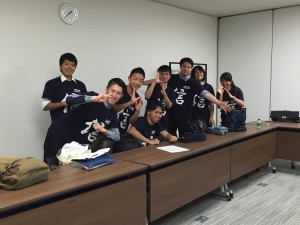
During our closing ceremony in Tokyo, JP-fellows shared their impressions of this program. I was so surprised that all of the members had different impressions of this program. Someone said that because of this program, she could achieve her dreams. In comparison, someone said that she found her future partner in this program. As for me, this program is the first step for my future plan, pursuing a Ph.D. in U.S. And, I was able to have many precious experiences in this program. I will definitely continue to play hard and study hard.
Finally, I really appreciate the Nakatani Foundation and Rice Unviersity for organizing this program. This experience has definitely been helpful for my future. And I also appreciate Nakatani-JP-fellows.
Final Report: Reflections on the Nakatani RIES Fellowship
When speaking to a family member, what would you say were the most important things you learned from the Nakatani RIES Fellowship program?
In Washington, we went to many museums. I want to talk about the Botanical Gardens with my mother because she loves flowers and plants. There are so many kinds of flowers and plants. If I tell her about how fantastic flowers and plants are, my mother may be happy. In the future, I will take my parents in U.S. (maybe this will be first time trip to U.S. for them.) Also I had a chance to watch sports games in U.S. I will share my memories of these sports games, especially baseball, with my father. He likes all sports. I cannot wait to talk about U.S. sport with him.
When speaking to a professor, what would you say were the most important things you learned from the Nakatani RIES Fellowship program?
First of all, I really appreciate the support of my professors, Koji Suzuki and Daniel Citterio, for approving my participation in this internship. If they had not approved my internship, I could not have joined this program. From this experience, I learned how difficult it is to conduct different kinds of research. In this program, I did a bioengineering experiment and everything was totally new for me. Therefore, I needed to ask my lab members a lot of questions at first. However, this experience was really helpful for me. In the future, I would like to conduct interdisciplinary research projects. As a first step of this future plan, exposing myself to different research areas was a very important thing to better understanding interdisciplinary projects are conducted. Moreover, this experience contributes to my communication with international students in my laboratory. There are many international students in our laboratory, coming from all over the world. I would like to contribute to helping international students to work more smoothly in our laboratory by utilizing my experience of this program.
When speaking to an employer, what would you say were the most important things you learned from the Nakatani RIES Fellowship program?
This research experience contributed to changing my impression towards research in U.S. At first, my impression towards U.S. research was that it was more like a company. We are given suggested research goals, and have to achieve it by the time limit. Therefore, we are always required good results to be competitive. In some aspects, this is true, however, U.S. research also has different aspects. First of all, U.S. laboratories provides research opportunities for undergraduate students. In the U.S., we could start our research experience even if were were only a freshman (B1) student. This is burden for researchers in laboratory because they have to teach freshman. Although this a burden, many U.S. labs accept many undergrad students. This is really good to contribute to the development of future potential researchers.
When speaking to a student at your university, what would you say were the most important things you learned from the Nakatani RIES Fellowship program?
Because I meet many different people, I was able to get many different perspectives during this program. This program provided a chance to meet people from many different communities. If we belong to the laboratory, our relationships are limited, so our perspectives tend to be narrow. However, in this program, I could talk with so many people. Depending on the community, viewpoints can be totally different. So I want to share my experience to my lab members and strongly encourage them to extend their community to get new relationships, not only with lab members.
Are there things you will do differently as a result of your participation in the Nakatani RIES Fellowship program?
During this summer, I joined Prof. Gang Bao’s lab as an “International student.” I had many difficulties in my life in the U.S. There are also many international students in our laboratory in Japan. The international students in Japan are often confused about the differences between their country and Japan, so I would like to help them. For example, how to prepare their living environment and how to deal with documents needed to learn in Japan. I am very glad if international students in our laboratory in Japan could work comfortably because of my help.
What advice do you have for future participant in the Nakatani RIES Fellowship for Japanese students?
I highly recommend that Nakatani candidates should consider their host lab carefully. In this program, we can get a precious research experience. However, potentially some mismatch could occur, especially among sophomore and junior students. This is because they usually do not have a clear vision of their future. As a result, this experience could be different form their expectations. To avoid mismatch between their expectation and research experience, they should consider potential host laboratories depending on their purposes. In my case, I had several criteria for my future career. Sophomores and juniors do not need to have a concrete vision, however thinking about what they want do, and how to utilize this experience in the future is helpful to fill a gap.
Final Question of the Week
Why do many U.S. students do not join club activity? In Japan, almost students join club activity. Furthermore, they said that even if in high school, U.S. students do not join club activity. This is surprising for me.
- High School Students: Actually, in the U.S. in high school most students are very involved in clubs and extracurricular activities and activities such as volunteering in the community. This is because when you apply to universities in the U.S. you are not just admitted based on your test scores and grades, they also look at your resume and what clubs/activities/organizations you have been involved in. In the U.S., for admission to undergraduate universities, they typically want to see that you are a ‘well-rounded’ applicant.
- Undergraduate Students: However, once you are in college, then as an undergraduate student you may only have time to join a few clubs or activities because you may be taking many courses and have a lot of homework or, perhaps, you are working a part-time job to help pay for school. As an undergraduate, because your time is more limited, you need to choose more carefully which clubs you want to be a part of. Student chapters of engineering professional societies are very popular and there are also clubs for women such as the Society of Women Engineers and minority students such as the National Society of Black Engineers. In addition to professional clubs, most universities in the U.S. have a long list of other clubs and student organizations you can join for arts, culture, volunteer, intramural sports, and many other activities. At Rice there are more than 200 student clubs.
- Graduate Students: As a graduate student you are typically not as involved in club or student organization activities as much because you must spend long hours working in the lab. All university clubs and organizations are open to graduate students and some, such as the Graduate Student Association, may be very active but oftentimes graduate students are more focused on their coursework and research and spend most of their time socializing with lab members.
- So it really depends at which level you are as student how much time you have to be an active member of student clubs and it varies greatly based on personal choice as well.
